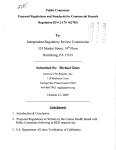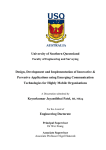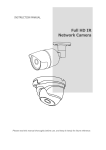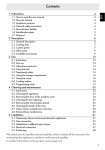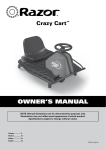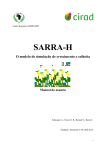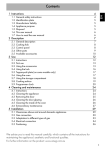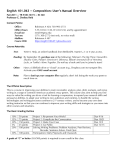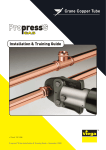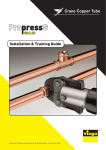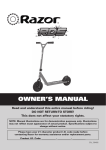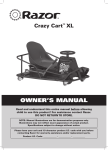Download Cooking with gas - Energy Safe Victoria
Transcript
www.esv.vic.gov.au January 2014 energysafe issue 34 Energy Safe Victoria Copyright © 2014 PP352583/00578 Story Pg 05 Cooking with gas ESV launches its new summer barbecue safety commercial Workers injured after touching powerline 06 Record fine for unlicensed electrical work 07 De-energising a site with an advanced meter 08 Government drops national licensing plans 09 AS/NZS5601: 2013 roadshow presentations 18 Gaining approval for mobile catering vehicles 19 LOOK UP AND LIVE OR DEAD AND BURIED REMEMBER LOOK UP AND LIVE Stay outside the 3 metre “no go zone” around, and above, power lines. Or you could end up 6 feet under. For further information visit Energy Safe Victoria www.esv.vic.gov.au or call 03 9203 9700. 03 For all the latest energy safety news visit www.esv.vic.gov.au January 2014 energysafe issue 34 Features Our cover Don’t be a silly sausage when barbecuing this summer and take the time to Look before you cook and to check your barbecue for gas leaks using soapy water. That’s the message of ESV’s new summer barbecue safety television commercial, which premiered this summer. 05 Photo: Mike Baker. ESV unveiled its new barbecue safety commercial for the Look before you cook campaign 11 Puppy power: A NECA Award winner talks about the challenges of building the new National Detector Dog Program Facility 13 You can now like ESV on Facebook and get important safety updates and ESV news delivered direct to your news feed. Don’t be the last to know about vital safety alerts, product recall notices or ESV news. Be one of the first 100 people to like us this month and we’ll send you one of our new Don’t work live T-shirts. Download this issue www.esv.vic.gov.au Working wetlands: Melbourne’s Royal Botanic Gardens has just finished a $6.5 million project to revitalise its lakes and save water News 06 Signage workers injured after contacting HV line 06 Paraglider pilot prosecuted for contacting HV lines 07 Magistrates’ Court issues record fine 09 Celebrating a lifetime of service 09 National Occupational Licensing scrapped 12 Aerial safety around powerlines 14 NECA winner’s moveable feast 18 Conference for people involved with Type B appliances 18 AS/NZS 5601:2013 roadshow coming to a venue near you 20 Plumbing scholarships awarded at Warrnambool TAFE Regulars Technical 15 22 23 23 08 De-energising a site where an AMI is present 19 Approval for mobile catering vehicles 20 Electrical and gas safety in caravans Electricity Q&A Gas Q&A Prosecutions and infringements Gas Technical Helpline update To contact ESV P (03) 9203 9700 E [email protected] For further information go to www.esv.vic.gov.au Published by Energy Safe Victoria Level 5 Building 2 4 Riverside Quay Southbank VIC 3006 04 Editorial From the editor Managing editor Sharon Rainsbury Editor Michelle Robertson Contributors Michelle Robertson Michael Weber Ignazio Cannizzo Enzo Alfonsetti John Stolk John Murphy Anthony Bottegal David Harrison Len Varker Neil Fraser Charlotte Roseby Laurie Devitt Jean-Marie Ntahonkiriye Editorial assistant Janice Williams Design Aer Design Authorised by Energy Safe Victoria Building 2, 4 Riverside Quay Southbank, VIC 3006 P 03 9203 9700 E [email protected] Printed by Flow Printing 68 Woodlands Drive Braeside, VIC 3195 I love a trip to the movies and it’s always exciting to see one of our community safety ads playing on the big screen. If you’ve been to the flicks during December and January I hope you noticed our new Look before you cook commercial, which is striking (and I hope memorable) for the fact that it presents an unusual scenario – friends gathering for a backyard barbecue in fire-resistant suits. The message is simple – there’s an easy way to keep your family safe around the barbecue this summer and you don’t have to look like an extra from The Hurt Locker to do it. Taking a few seconds to check your gas connections with soapy water is all you need to do to ensure that the sausages are the only thing that’s going to get burnt at your next barbecue. Our ad is deliberately humorous and it’s always good to hear cinema goers laugh when one of the unwitting barbecue guests in the ad tries to take a bite of his sausage and instead slams it into his suit’s helmet, smearing mustard as he goes. But behind the humour is a serious message that we want every Victorian to hear. Barbecues are a tradition in Australia and something that thousands of us do every day during the warmer months. The vast majority of barbecues take place without incident, but on average more than 130 barbecues end with disastrous consequences every summer. The majority of fires are caused by loose gas connections that have not been adequately tightened or perished O rings. Taking a few seconds to check your connections are tight and to squirt some soapy water on the connection between the gas bottle and hose, and the hose and barbecue, will show you if your barbecue is safe to use. If you see bubbles forming, then you have a gas leak. As our ad says, no bubbles and you’re good to barbecue. The ad will also be screening on television in the lead-up to Australia Day so keep an eye out for it and remember to Look before you cook this summer. And now some exciting news about this magazine. We are moving to an electronic format for the April and October editions of EnergySafe so those of you that still receive a printed copy will only receive the January and July editions in your letterbox. The April and October editions will be available online and we’ll be emailing everyone on our database when they are ready so please ensure we have your current email address on file so that you don’t miss out. Electricians can update their address details through the Online Services portal at www.esv.vic.gov.au, while VBA (PIC) licence holders can update their details through the eToolbox at www.pic.vic.gov.au. Thanks to everyone who has taken the time to update their information in the past months. Sharon Rainsbury [email protected] Copyright All material appearing in EnergySafe is copyright. Reproduction in whole or in part is not permissible without the written permission of EnergySafe Victoria, depending on the source of the article. Advertise with us! Liability Howsoever arising as a consequence of use or reliance upon any advice, representations, statement, opinion or conclusion expressed herein is expressly denied by Energy Safe Victoria and all persons involved in the preparation of this publication. EnergySafe has a circulation of more than 45,000 copies and is published four times a year. It provides readers with authoritative articles on safety, technical and regulatory information and news of prime importance to the electrical, gas and pipeline industries. EnergySafe goes directly to Victoria’s licensed electrical installation workers, registered electrical contractors, licensed electrical inspectors and gasfitting specialists as well as many other stakeholders including TAFE colleges. Full page $5000 Half page $2500 One third page $1700 Quarter page $1500 Contact us for a our latest media kit or to book your next advertisement. For advertising information and bookings contact Michelle Robertson on P (03) 9203 9743 E [email protected] 05 For all the latest energy safety news visit www.esv.vic.gov.au January 2014 energysafe issue 34 New look for annual barbecue safety campaign By Michelle Robertson, Senior Media and Communications Adviser ESV kicked off its annual barbecue safety campaign with a Look before you cook launch on the eve of summer at Federation Square. With a prime position on the Swanston St edge of the Square, ESV set up an information stand and quickly attracted visitors with the lure of a free sausage sizzle! An estimated 1000 Melburnians visited during the event, receiving vital safety information and a free soapy water test bottle to use at home. ESV experts from the GIAS team were present to chat about gas safety and personally demonstrate how to do a simple soapy water check on barbecue hose connections. The Minister for Energy and Resources, Nicholas Kotsiras, dropped in and took the opportunity to watch ESV’s new TV commercial, which has been screening in cinemas and will be seen on TV in the lead up to Australia Day. Produced by Redhanded Creative and Airbag Productions, the ad takes a humorous look at a family gathering with a difference. All the guests are dressed in bomb protection suits as the barbecue hasn’t been checked for gas leaks! The host soon realises there’s an easier way Cooking with gas: The crew prepares to film a scene for ESV’s new television commercial (above), while Minister Nicholas Kotsiras helps out at ESV’s Federation Square barbecue safety event (left). to keep everyone safe and that’s to use soapy water to check for leaks. Once this has been carried out, the guests are shown in normal attire. As well as the new television commercial, radio ads have been running throughout summer and ESV is planning more public information events over the coming weeks to make sure as many Victorians as possible know to look before they cook. You can view the new commercial at www.esv.vic.gov.au 06 Latest news Signage workers injured after contacting HV line In mid-November, two signage workers were severely injured after accidentally making contact with a 22,000 volt powerline. The pair was working on a billboard in North Carlton via a truck-mounted elevated work platform that was located under the powerline. The two men received significant electrical burns when a length of aluminium fixing material they were handling made contact with the 22,000 volt line. They were taken to the Alfred Hospital and admitted with severe injuries that will have a lasting impact on their lives. A subsequent investigation found they were operating in contravention of the No Go Zone framework, with none of the obvious controls that are usually apparent in place, nor did they meet the requirements of a Permit to Work. ESV reminds everyone that any work planned to occur close to powerlines and within a No Go Zone requires a Permit to Work from the owner of the overhead electric line. The permit will prescribe the conditions required for work in the vicinity of the powerlines, including the use of trained, registered spotters and requirements for the isolation of the electrical asset by its owner before the proposed work can occur. WorkSafe and Energy Safe Victoria developed and support the No Go Zone framework that requires stipulated distances from powerlines to be maintained, incorporates appropriate use of spotters and enables Permits to Work. All the information can be found at www.worksafe.vic.gov.au or www.esv.vic.gov.au Paraglider pilot prosecuted for contacting HV lines In November ESV prosecuted a pilot in the Bendigo Magistrates’ Court for making contact with high voltage conductors and causing a loss of power supply. On 8 February last year the paraglider made contact with overhead high voltage conductors at Bridgewater. No serious injuries were sustained but the incident resulted in loss of supply to 1314 customers. A legal investigation was carried out that resulted in the prosecution and the pilot being found guilty of the offence, given a good behaviour bond for 12 months and ordered to pay costs of $2000. ! y a d i l o H a e Get m We provide safety advice and strategies for safe flying near powerlines on Pg 12 of this edition of EnergySafe You could win … 2 nights for 2 people in the luxury ocean view spa roo m with full bu ffet breakfas t. Flights and tra nsfers includ ed. valued at $3,500 Employ an apprentice using the Energise Oz National Apprentice Register by 25 February 2014 and you could getmeaholiday win a trip to the Gold Coast. .net.a for details Powerlines pose a major risk for pilots engaged in low-level and recreational flying. Pilots must be aware of the regulations regarding safe clearances and take a range of precautions to reduce the risk of serious accidents and disruptions to supply. u managing apprentice progression 07 For all the latest energy safety news visit www.esv.vic.gov.au January 2014 energysafe issue 34 Magistrates’ Court issues record fine for breaches of the Electricity Safety Act By Sharon Rainsbury, Executive Manager Media and Communications Energy Safe Victoria has successfully prosecuted a Golden Square man on 47 charges relating to unlicensed electrical work and unsafe electrical work. Michael Sukit Llewellyn, of Symons St Golden Square, did not appear in the Ringwood Magistrates’ Court when the matter was heard before Magistrate Peter Dunn on 1 November. Mr Llewellyn was convicted of 37 counts of doing unlicensed electrical work, six counts of unsafe work, two counts of working without registration as a registered electrical contractor, and two counts of giving false information on a Certificate of Electrical Safety. He was fined $67,500, plus costs of more than $5000. It is the highest single fine ever issued by a court in relation to breaches of the Electricity Safety Act. Prosecutor John Murphy of ESV alleged that Mr Llewellyn had been doing a range of electrical work even though he was not licensed, and subsequent inspections of that work found that it was unsafe and non-compliant. A witness called by ESV described Mr Llewellyn’s work as the “highest level of unsafe work possible”. “On a scale of one to 10, it rated a 10.5,” the court was told. Magistrate Dunn was told Mr Llewellyn, who traded under the name MBK Electrical even though it does not appear on Victoria’s register of business names, had worked widely across the metropolitan area, including Mont Albert and Maribyrnong. Mr Murphy for ESV was told Mr Llewellyn’s victims faced total bills of up to $40,000 to rectify his unsafe and non-compliant work, and to complete unfinished work he had been paid for in advance. A licensed plumber who engaged Mr Llewellyn to do electrical work associated with the installation of split system air conditioners also faced costs of $2000 inspecting and rectifying Llewellyn’s non-compliant work. Magistrate Dunn said that if a jail sentence had been available to him as a sentencing option under the Act, it would have been appropriate in this case. Victoria’s Director of Energy Safety, Paul Fearon, said the size of the fine indicated how seriously ESV and the courts treated electrical safety issues. Mr Fearon warned Victorians against employing anyone who was not a registered electrical contractor. “Consumers should ask to see the registration card or check the ESV website to ensure the person doing the work was appropriately registered,” he said. “If you have any concerns about a contractor’s credentials then contact ESV and we will be able assist, and will follow-up if necessary. “ESV takes the safety of Victorians very seriously and we will prosecute those who are doing electrical work without the appropriate licence.” 08 Latest news De-energising a site where an AMI is present By Neil Fraser, ESV’s Executive Manager Electrical Installations, Licensing and Equipment Safety With the near completion of the Advanced Metering Infrastructure (AMI) rollout, distribution businesses now have access to improved reporting and control of the supply to properties. AMI, also known as smart meters, have the ability to monitor in real time voltage, current and temperature. They also enable the remote de-energisation and re-energisation of the premises. This means that the distribution business (DB) may no longer be pulling the service fuse to de-energise a site where an AMI is present. This means de-energisation will involve remotely or locally opening the contactor within the meter. Re-energisation will involve closing the contactor within the meter and, if possible, this will be performed remotely. The customer’s main switch must be OFF prior to performing any remote re-energisation. During remote re-energisation the AMI will automatically disconnect if a load is detected. The service fuse (or supply disconnect fuse) must be removed prior to commencing any electrical work. This must be done in line with The Code of Practice for LV Fuse Removal and Reinsertion. Notify the DB prior to the service fuse removal with the following information: » Name, licence number, contact phone number » Customer name and address » Reason for disconnection » Proposed reconnection time » Test to ensure all circuits are dead » Notify the DB after fuse reinsertion It is essential that these steps are followed to prevent electrocution. You’ll find further information at www.esv.vic.gov.au Beware the dangers of remote controls and automation By Neil Fraser With today’s focus on energy efficiency, automation and remote control it is important to realise that the devices used to achieve these features may pose a risk to electricians, particularly in lighting circuits. These devices, known as electronic dimmers or switches, do not isolate the circuit. They use electronic switches like triacs and transistors to control the output but do not provide galvanic isolation or disconnection. In an installation it is a requirement that isolation for service or repair be provided; this is the circuit breaker or fuse and can no longer be considered the wall switch. It is also important to remember that many pieces of equipment can now be controlled ELECTRICAL INSPECTIONS VICTORIA www.eivic.com.au remotely using a smart phone, ripple control or the internet. This means that many fixed wired appliances including air-conditioners and stoves can switch on unexpectedly endangering electrical workers. Even socket outlets may be remotely controlled, so the message is to always isolate at the switchboard and never work live. Electrical Inspections Victoria provides electrical inspection and consulting services to registered electrical contractors, developers and supply authorities across Victoria. Electrical Inspections Victoria has the experience, qualifications and resources to provide the service you need. For more information call us today 03 9739 4216 09 For all the latest energy safety news visit www.esv.vic.gov.au January 2014 energysafe issue 34 Celebrating a lifetime of electrical service ESV recently recognised Bruce Johnson’s 60 years of service to the electrical industry. Michelle Robertson reports. When Bruce Johnson started working in Victoria’s electrical industry in 1949 the average weekly wage for an apprentice was around six pounds. Since then the industry has seen much change but some things – or people – remain constant. Such is the case with Bruce, who contributed 60 years of service to the electrical industry, and for which he recently received a certificate from ESV. Bruce was apprenticed to Oliver J. Nilsen Pty Ltd in 1949, doing general wiring work as an apprentice electrical mechanic. Toward the end of his apprenticeship he worked on the new Thomas Owen Paper Mill in Burnie, Tasmania, carrying out most of the power and control wiring on the multi-drive paper machine. Bruce obtained his A Grade Electrical Mechanics’ Licence and worked throughout the 1950s and ‘60s on a number of key projects including Ballarat Power Station, Kyneton Abattoirs and Alfred Hospital kitchen. From 1961-63 Bruce was site supervisor for stage one of Monash University, including overseeing the construction of two 22,000 volt substations. This was followed by three years as site supervisor on the Reserve Bank project in Collins Street. “During the times I acted as site supervisor, it was necessary for me to work on pricing of variations, liaise with clients and also make all necessary arrangements with both the SECV and MCCES,” recalled Bruce. In 1967 Bruce joined the Commonwealth Department of Works as Electrical Works Supervisor. He remained there until 1993, contributing his expertise to the new Tullamarine Airport and numerous defence projects. During this time he completed a High Voltage Operator’s course through the SEC at Oakleigh. Throughout the 1990s Bruce started to scale back his work, working part-time for Shell and also Emyss Electrical Contractors and Earth Electrical Contractors carrying out estimating, contract administration and safety assessments. Bruce is now retired but still has a direct link to the industry through his son, Greg, who is employed as an Electrical Compliance and Enforcement Officer at ESV. National Occupational Licensing scrapped The Federal Government has scrapped plans for National Occupational Licensing. The decision was made at the December COAG meeting and the following statement was released. National occupational licensing scheme COAG noted that, following the outcome of extensive state-based consultation, the majority of states decided not to pursue the proposed National Occupational Licensing Scheme reform (NOLS). Most jurisdictions identified a number of concerns with the proposed NOLS model and potential costs. States instead decided to investigate approaches that would increase labour mobility and deliver net benefits for businesses and governments. To this end, states agreed to work together via the Council for the Australian Federation to develop alternative options for minimising licensing impediments to improving labour mobility and to manage the orderly disestablishment of the National Occupation Licensing Authority from early 2014. Rmit Apprentices – Ready for Your Business RMIT’s apprenticeships are designed to address workplace trends and employer needs. They are nationally accredited and developed in close consultation with industry. Classes are delivered by teachers with industry experience, using first class facilities. This ensures your apprentice will be familiar with industry standards and ready to start work. RMIT can even help tailor a program to suit your business needs. Study options may include online, block release (one week - six times or more a year) and day release (one day per week). Classes are centrally located in Melbourne’s CBD. 0ROGRAMS INCLUDE s #ERT )) IN %LECTROTECHNOLOGY PRE APPRENTICESHIP s #ERT )6 IN %LECTROTECHNOLOGY )NSTRUMENTATION s #ERT )6 IN 0LUMBING AND 3ERVICES s #ERT ))) IN %LECTROTECHNOLOGY %LECTRICIAN s #ERT )) IN 0LUMBING PRE APPRENTICESHIP s #ERTIlCATE )) IN %NGINEERING s #ERT )6 IN %LECTROTECHNOLOGY 3YSTEMS %LECTRICIAN s #ERT ))) IN 0LUMBING s #ERTIlCATE ))) IN !IRCONDITIONING AND 2EFRIGERATION 4HIS TRAINING IS DELIVERED WITH 6ICTORIAN AND #OMMONWEALTH 'OVERNMENT FUNDING > Enrolments are accepted throughout the year. For more information phone 9925 4468 or email [email protected] www.rmit.edu.au/programs Victorian Electricity Distributors Service & Installation Rules 2014 Seminars Available SIR Books ase for Purch n.au/VIC ca.as at www.ne Commencing in early February 2014, NECA is conducting a limited series of industry briefings on the final changes to the SIR’s that become effective from 1 April, 2014. To register, go to www.neca.asn.au/VIC. Bairnsdale Tues 4 Feb 7.30 – 9.30am Werribee Wed 12 Feb 7.30 – 9.30am Dandenong Thur 20 Feb 4.30 – 6.30pm Pakenham Thur 27 Feb 4.30 – 6.30pm Bendigo Wed 5 Mar 4.30 – 6.30pm Traralgon Tues 4 Feb 4.30 - 6.30pm Ballarat Wed 12 Feb 4.30 – 6.30pm Horsham Tues 25 Feb 7.30 – 9.30am Mildura Tues 4 Mar 7.30 – 9.30am Melton Thur 6 Mar 4.30 – 6.30pm Wonthaggi Wed 5 Feb 4.30 – 6.30pm Bentleigh Thur 13 Feb 4.30 – 6.30pm Tullamarine Tues 25 Feb 4.30 – 6.30pm Swan Hill Tues 4 Mar 4.30 – 6.30pm Frankston Thur 6 Feb 4.30 – 6.30pm Albury / Wodonga Tues 18 Feb 7.30 – 9.30am Bulleen Wed 26 Feb 4.30 – 6.30pm Warrnambool Tues 11 Feb 7.30 – 9.30am Shepparton Tues 18 Feb 4.30 – 6.30pm Geelong Tues 11 Feb 4.30 – 6.30pm Croydon Wed 19 Feb 4.30 – 6.30pm Proudly supported by 11 For all the latest energy safety news visit www.esv.vic.gov.au January 2014 energysafe issue 34 Puppy power Electrical Design & Construct received a Victorian NECA Award for Excellence for the high standard of electrical work on the National Detector Dog Program Facility. Charlotte Roseby hears about their work. At the National Detector Dog Program Facility on the outskirts of Melbourne, the Australian Customs Service breeds, develops and trains dogs – and their human handlers – for a working life in customs and border protection. The 8.9ha facility is world-class. It includes 3300sqm of dog kennels, over 100 day runs, a whelping area for pups, a “kennel support hub” with a vet clinic and onsite staff providing aroundthe-clock care. The facility allows the Detector Dog Program to develop the dogs, train handlers, and conduct highly targeted training courses in surrounds that closely mimic customs and border protection environments. The dogs are being trained for a very serious role: to detect hidden foods, currency, illicit drugs, firearms and weapons. Powering up kennels, mock houses and conveyor belts Well before the dogs moved into their new home, the team from Electrical Design & Construct arrived on the scene for the electrical installation. They had a big job ahead of them: all power reticulation – switchboards and distribution boards – general lighting and power, automated lighting control system, data and external lighting. They spent three or four months doing underground work because the job was so spread out, says Stuart Barker of Electrical Design A winning tail: The team from Electrical Design & Construct had to look at everything from a dog’s perspective to ensure their work was puppy-proof. & Construct. It was a huge site: 20 buildings on more than 6ha. “The scale of the site was all-consuming,” says Stuart. “For a company used to large offices and warehouse complexes, it was certainly out of the ordinary for us.” To tackle the job, Stuart and his team decided on an approach they’d never tried before: instead of dividing the roles, they created small teams and assigned each team a building. It paid off. By giving each group responsibility for its own site they were able to achieve a very high standard of work plus a sense of pride in each building. Alongside this novel approach Electrical Design & Construct had a comprehensive health and safety regime in place. They were regularly audited and were happy to report no lost-time injuries over 12 months. There were many technical challenges in the design and construct process, says Stuart. “We were responsible for making an ingenious concept into reality, so there was a bit of innovation and a lot of ‘making things work’.” In the puppy whelping area, the detector dog program needed something to keep the new puppies warm. They couldn’t find anything Team effort: The job was so large the company tried a new approach, creating small teams with each assigned a building and given responsibility for the site. on the market so Stuart’s team made their own. They ended up adapting a regular commercially available desk lamp with an adjustable height, turning it into an infrared heating lamp. Electrical Design & Construct were also responsible for the energy efficiency of the facility. This was achieved using a combination of occupancy sensors, C-Bus controls and daylight harvesting. They programmed everything in-house. They might be highly trained, but the dogs and puppies in the Detector Dog Program still can’t resist chewing a cord or gnawing a loose panel. To puppy-proof and dog-proof the installation, Stuart had to think about every single piece of equipment and cabling from a dog’s point of view. They ended up with a simple rule “Keep everything up as high as you can, and whatever you put down low has to be as strong as you can.” As well as the “puppy factor” they also needed to make sure all the buildings were compliant with the Disability Discrimination Act, which meant large switch mechs and very specific mounting requirements for switches and GPOs. A barking success The project was declared a great success, and, after 12 months, the Electrical Design & Construct team returned to its headquarters in Hallam. A few months later, the electrical team was called back to the facility. Even though it was no trouble for the four-legged team members – the two-leggeds were having trouble getting around the 8.9ha of grounds. Electrical Design & Construct was happy to help make the working day easier for the staff of the National Detector Dog Program, and installed battery chargers for a fleet of golf carts. Stuart says they were thrilled to get to see the dogs and puppies settled into their new home. “We got a much better idea how the place worked. It was a totally different place when we returned … It was so loud … It was full of barking!” Electrical Design & Construct received a Victorian NECA Award for Excellence for the high standard of its electrical work on this project. 12 Electrical news Flying near powerlines Powerlines pose a serious risk for those engaged in low-level flying. A spate of recent incidents has seen aircraft contacting high voltage SWER lines in regional areas and the risk is particularly high when crop dusting. When flying, powerlines are sometimes difficult to see as they can blend in with background vegetation or the sky. Pilot awareness of powerlines while on the ground doesn’t always equate to awareness in the air. Anyone engaging in aerial activities risks serious injury or death if they make contact with powerlines. Know the regulations The most important rule is that aircraft must always maintain a safe clearance of 45m from electrical installations. Victoria’s Electricity Safety (Installations) Regulations 2009 state: A person must not launch, release, operate, fly or land any aircraft, glider, hang glider, hot air balloon, parachute, mechanically propelled model aircraft, model glider or kite within 45m of a relevant installation that is above the ground. The exception is where an emergency landing in the vicinity of powerlines or electrical assets cannot be avoided. Otherwise, the regulation must be observed unless an exemption has been granted by ESV. On rare occasions exemptions are granted for low flying, such as when this is required for agricultural spraying. In these cases a written application must be made to the Director of Energy Safety along with the payment of an exemption fee. Understanding the electrical network from above Pilots and crews should understand the basic structures of the electricity network so they can interpret what they see when flying. Multiple high voltage wires may be present in some areas but in regional Victoria the SWER system can be strung in spans of up to 400m and both wire and poles can be difficult to see when flying. Houses and sheds are also likely to have power connected through overhead structures. Roads often provide a corridor for powerlines and pilots can gauge the path of a wire by identifying at least two poles from the air. Crossarms can also provide information as to the number of wires and their direction. Strategies for safe flying If you are planning low-level operations you should discuss powerline locations with property owners and conduct ground-level and high-level pre-flight reconnaissance. Pilots and crews should: » Always be on the lookout for powerlines – expect to see them anywhere in the lead up to farm buildings. In rural and remote areas they often go across land and paddocks » If you can obtain them, study maps of the flight area before you fly to identify the location of powerlines but be aware that they are not always marked on maps » Don’t fly at low level unless authorised – it’s especially difficult to see powerlines and it gives little or no margin to recover from unexpected events » Use both memory and awareness when flying because powerlines can be anywhere – including very remote areas – and can sometimes be hidden by vegetation » Don’t rely on marker devices to alert you to the location of powerlines – powerlines under a certain height are not required to have marker devices fitted » Clearly and verbally identify all structures if flying with others » Apply appropriate flying techniques » Read the physical structure indicators, eg poles and crossarms and pole shadows may help you identify the presence of wires » Consider the weather and lighting conditions » Don’t deviate from low-flying routes or away from areas that are already known to be clear of powerlines and other cables The Essential First Step of any excavation. Visit www.1100.com.au or call 1100 during business hours. » Fly across powerlines at poles or structures rather than mid-span where possible » Fly along the line of the powerlines when necessary, such as in thick fog or low visibility, always keeping in mind off-takes are normally at right angles to these lines » Be aware of reduced powerline heights resulting from damage – uneven cables, excessive sag or slack stays may indicate damage » Stay clear of damaged or fallen powerlines and report them to the distribution business immediately. If contact with powerlines occurs If contact with powerlines does occur the following steps help minimise further risk: » Cut off the aircraft’s fuel supply to reduce the risk of fire » Assume powerlines are live – never touch them, even if they are not sparking » Call 000 immediately to have the power turned off » If you are in a grounded aircraft or vehicle and it is safe to do so, stay inside the cabin – do not leave the cabin until the power has been switched off » Be aware that once a wire is on the ground you could still be injured or killed without touching it – the current may travel a significant distance through the ground and even further if the wire has fallen on a metal fence or object » Keep bystanders at least 8m away from the aircraft or vehicle and anything else in contact with powerlines » If immediate evacuation of the cabin is necessary: › Jump well clear, ensuring you don’t touch the aircraft or vehicle and the ground at the same time › Don’t approach or attempt to rescue others involved in an electrical accident – wait for trained emergency workers to arrive. 13 For all the latest energy safety news visit www.esv.vic.gov.au January 2014 energysafe issue 34 Working Wetlands at the Royal Botanic Gardens The Royal Botanic Gardens Melbourne has just finished a $6.5 million project to revitalise the lakes, improve the irrigation in the gardens and save water. Charlotte Roseby reports. The Royal Botanic Gardens Melbourne is a complex site to manage: 38 hectares of gardens, 50,000 plants (10,000 different species) and over 1.5 million visitors a year. The RBG has been a leader in water conservation, making huge reductions in water use over the last decade. But years of drought, the growth of Melbourne’s population and the effects of climate change have put the gardens under extra pressure. Now, the RBG’s $6.5 million sustainable water management project, Working Wetlands, is improving water quality, restoring lake levels, and providing treated stormwater suitable for irrigating the gardens. Guilfoyle’s volcano flows again The first major step in the Working Wetlands project was to restore Guilfoyle’s Volcano. Of course, there’s no actual volcano in the Royal Botanic Gardens. Originally built in 1876 (under the direction of the second director of the gardens, William Guilfoyle), Guilfoyle’s Volcano is a spectacular bluestone-lined water reservoir that rises up out of the ground in the eastern edge of the gardens. Guilfoyle positioned the volcano at the highest point in the gardens to gravity-feed down through the gardens. The RBG reconstructed the volcano and returned it to its original use as water storage. It’s now an important part of the water treatment system, the recirculation system and, ultimately, the watering system. Utilising local stormwater Previously, the gardens could only utilise water from its own internal catchments. The installation of new stormwater harvesting pipes now means water can be intercepted from adjacent streetscapes, capitalising on an additional catchment area of 21.1ha. Two large gross pollutant traps strip out large materials like bottles and cans, but also have the capacity to collect smaller pollutants and hydrocarbons. The system can supply up to 40 per cent of irrigation water per year. Floating treatment plants Next up in the Working Wetlands project is floating treatment wetlands. Made from recycled PET plastic injected with a marine-grade polyurethane for buoyancy, the new wetland “islands” are covered in coconut fibre matting and planted with an assortment of Indigenous, semi-aquatic plants. Working Wetlands: Melbourne’s upgraded Royal Botanic Gardens. Photo Jorge de Araujo. The beauty of these plants is that their roots, suspended in the water, trap fine particles and absorb nutrients, effectively cleaning the water. The microorganisms, present in the biofilm covering the roots, increase the efficiency of this process. The RBG now has 14 of these water-cleansing islands, creating a surface area of over 1000sqm. Moving water: pipes, pumps and power The final stage of Working Wetlands was building, installing and powering the infrastructure to move the water around the site more effectively. The system now boasts its own stormwater capture, gross pollutant traps, pump station, and water treatment plant with tank storage and UV disinfection as well as new pipework. “The biggest challenge was integrating the water sources,” says James Young of the sustainable water company, Total Eden, which installed the pump stations, electrical switchboards and automation in the project. The task included integrating the infrastructure for drinkable water, tank water, stormwater and water from the storage lake. The gardens needed the capacity to switch, at a moment’s notice, between potable supply and lake water for irrigation. Total Eden installed a complicated integrated control system that controls opening and closing the valves of each water source. “The PLC-based system integrates with the gardens’ irrigation system, which is centrally controlled. The control system for the pump station works from pressure transducers based on tank storage at the time.” Total Eden also needed to redesign communication between existing central control irrigation and PLC automation. They chose radio link rather than using cable, says James, because cable would have run the risk of disrupting the plant environment. Safety first Electrical safety was uppermost in their minds throughout the project, says James. They needed to upgrade an electrical pillar and the electrical switchboards to bring them up to standard. “Safety is very important in an environment like this with existing electrical services belowground – some of them very, very old. We needed to start by identifying what existing services, which boards – what existing equipment and infrastructure is in the ground.” Electrical contractor Greg Russell of GJR Electrics had a team of six electricians to connect power for the treatment plant, transfer pumping station and control systems. “Working in such a public area always provides a few extra safety challenges,” says Greg. “There were so many tourists, usually looking the wrong way! The teams worked hard to keep their work separate from garden visitors and residents like the bats and possums.” Both Greg and James said their teams were thrilled to be working on this particular project. “The gardens are so important to a lot of people,” says Greg. “It mightn’t have been the largest or most lucrative job, but it was certainly one with the highest expectations and the highest respect. We were so pleased and proud – particularly to be there to turn it on … And what a great environment to be working in!” Green power The Working Wetlands are now working well. The water quality in the lake system is higher, and the phosphorus levels in the water have dropped around 50 per cent compared to the previous decade’s average. The wetland areas are helping to attract and retain waterbirds and other native aquatic fauna in the lake system. While the project has reduced the RBG’s reliance on potable water for irrigation by up to 40 per cent, it has also resulted in a higher energy requirement for the gardens. The gardens now boast state-of-the-art photovoltaic panels for solar energy on the roof of the Visitor Centre, Herbarium and on top of several sheds in the works yard. The PV panels are the first stage of a carbon offset strategy that will see almost 60 per cent of the Working Wetlands electrical use offset by the green power. 14 Feature NECA winner’s moveable feast Charlotte Roseby meets Warren Bradford of Deacam – Victorian NECA award winner and specialist in getting microbreweries and wineries running smoothly. It sounds like the blokes at Deacam have the best electrical job in Australia. Actually, given the quality of Victorian wines, ciders and beers, perhaps the best job in the world. Deacam is an industrial electrical contractor specialising in, among other things, automated operations of distilleries and wineries in the glorious Yarra Valley. We know that most electricians like beer – was this area of specialty intentional? No, says Warren Bradford, electrical contractor, founder and director of Deacam. They fell into it. From cranes to cases and corks After starting out learning about industrial electrics, Warren joined JDN Monocranes, apprenticed directly to an electrical engineer. Working with hi-tech overhead travelling cranes gave Warren the know-how of industrial motor control, programmable logic controllers (PLCs) and integrated sensors. Since then, Deacam has been working in some exciting areas such as conveyors, overhead cranes, turbine and diesel power generation, ice making, air conditioning and automation. Deacam’s more recent work has really given it the taste for food and wine machinery automation. For Bio Dynamic, which despatches organic goods around Australia, Deacam developed a system to avoid the regular mains power outages to their packing shed on frosty mornings. “We came up with a solution of an 88KVA Olympian generator, coupled to our own designed and manufactured PLC automatic transfer switch, and it now automatically detects a power failure and switches over. The people operating the registers in Melbourne now only have 35 seconds before they’re back online. The system is simple, but it’s got some inherent smarts in there,” says Warren. His team also recently created a conveyor system to save time at Ricci’s Bikkies (Australia’s top producer of pita chips), developed an automated SCADA and PLC system for the White Rabbit brewery (which produces 30,000 bottles of beer a day) and automation for Kellybrook winery (producers of 20,000 cases of cider every year). Award-winning work It was the work for Oakridge Wines that won Deacam the Victorian NECA Excellence Award for a Small Contracting Business. Warren and his team designed an automatic system, a new control centre and field devices that enabled Oakridge to process trade waste onsite. As Warren explains, the wine-pressing process produces surplus water, grape skin, and grape seeds, all mixed in with grape juice, which can’t be released to stormwater and is usually carted away for disposal – an expensive and wasteful process. Keenly watched by other winemakers in the area, Deacam designed a PLC with a human– machine interface and linked up a number of pumps to create an aeration and bioremediation system in which bacteria use the air and munch on the dissolved solids in the water. “In the reactor at the bottom of the tank a dissolved oxygen sensor gave us feedback on how well the bugs were chewing,” says Warren. “By programming the PLC, the system ties together to form a fully automated solution. The operators can set and forget the system, and the automation responds, based on how much wastewater is coming in.” The challenge in winemaking, says Warren, is that the processing parameters change according to the amount of rainfall the vines have received, and the variety of grape. “We were getting false readings. We discovered, by pure trial and error, that the gravity of the liquid was changing according to the harvest.” Deacam changed the immersed pressure sensor to an above-mounted ultra-sonic sensor, which beams soundwaves down to the top of the level of the liquid and measures the distance from liquid to the face of the sensor to determine the amount of liquid. After finally working out a way of taking into account the bubbly foam on top of the tank they were relieved to finally see perfect readings. “We’re not electrical engineers, so for us the hardest part was writing the code and linking it with the HMI. We basically taught ourselves that part of the job by thrashing it out, weekend after weekend … and now we’re really good at it. And it works.” Oakridge can now control the entire process from waste liquid collection to batching, and use the wastewater on the vineyard for irrigation. “We come to industrial automation from a unique point of view, precisely because we’re electricians. A lot of what we see is not so well done because the wiring just comes later, more as an afterthought.” Victorian electricians: best in the world The team’s ability to teach themselves to write code to integrate with HMIs puts Deacam in the top level of automation, says Warren. As he said in his impassioned NECA acceptance speech, he’s proud of his team, but also he’s so proud of his industry. What we often take for granted, says Warren, Riding on the shoulders of giants: Warren Bradford of Deacam says the Victorian electrical industry should be recognised for its extraordinary engineering ability. is the extraordinary engineering ability in the Victorian electrical industry. “International companies tell us control panel building in Australia is the best. I’ve worked all around the world. The best way to describe what we are, outside of Australia, is electrical engineers. Electricians in other places around the world just don’t have the trade-based training – ours is second-to-none. “I feel very humbled … The skills we have are incredible. Hands down, Victorian electricians are the best in the world.” Riding on the shoulders of giants We got here, says Warren, from a history of Victorian excellence in manufacturing. “In the post-war manufacturing hub of Melbourne in the 1940s, ‘50s and ‘60s, there was nothing we couldn’t do.” Melbourne was indeed the centre of Australian manufacturing – marked by the moment in 1948 when Prime Minister Ben Chifley welcomed the first Holden off the production line. Manufacturing output in this era was growing rapidly, and creating far more new jobs than other parts of the economy. Iron and steel, motor vehicle and parts manufacture, electrical and electronic equipment, machinery and engineering were expanding rapidly, while the older industries, such as textiles, footwear and furniture, decreased. “There was a huge manufacturing industry and everyone just had to keep up: boiler makers, tool-makers, people who had to make the valves … and electricians,” says Warren. “This produced generations of top-level electricians and allowed us to compete on a world stage. I remind my boys, ‘We’re riding on the shoulders of giants’.” 15 For all the latest energy safety news visit www.esv.vic.gov.au Your electrical questions answered! January 2014 energysafe issue 34 Compiled by ESV’s Electricity Technical Advisor, John Stolk EnergySafe continues its regular series featuring some of the questions that ESV receives on a range of electricity installation issues, some of them relating to gas installations. Also provided are the answers together with references to the Acts, Standards, Regulations and Clauses that apply to them. Question Answer Standard Clause Does the switchgear supplying emergency equipment (safety services) need to be segregated from switchgear supplying the rest of the installation within a switchboard? Yes, where emergency equipment is required by National Building Codes, all switchboards that sustain supply to such equipment shall be constructed so that the emergency equipment switchgear is separated from other switchgear by metal partitions designed to minimize the spread of a fault from the other switchgear to the emergency switchgear. AS/NZS 3000:2007 Clause 7.2.8.1 & 7.2.1.1 Note 2. & 7.2.2.1 The term “safety service” incorporates equipment determined as emergency equipment in the Building Code of Australia. I have a five-unit subdivision where the main switchboard and metering are located at the front of the property. Do I need to install earth conductors between the main switchboard metering enclosure and each unit’s switchboard or can I install separate MEN installations at each unit? Protective earth conductors should be installed from the main switchboard to the switchboard in each unit. This method is recommended in all circumstances however where there is no possibility of creating parallel paths between the earth and neutral a separate MEN can be installed at each unit under the following conditions: (a) if each structure is separated by land; and (b) there are no conductive services or building material that could electrically connect the separate MEN installations. AS/NZS 3000:2007 Clause 5.5.3.1(b) Do I need to connect an earth conductor to each removable painted panel of a metallic enclosure containing single insulated conductors, or will the bolts that fix the panels to the frame provide the earth continuity if the earth conductor is fixed to the frame? Star or cutting washers or similar devices that can effectively displace/cut through paint or similar coatings are considered to be an acceptable method of ensuring earth continuity across bolted or clamped joints between metal equipment panels or framework that have painted or coated surfaces. AS/NZS 3000:2007 Clause 5.5.4.1 Is electrical equipment such as an exhaust fan installed in the ceiling of a bathroom above a shower considered to be installed in Zone 1? Electrical equipment recessed into a ceiling such that all live parts are above the lower surface of the ceiling are considered to be outside Zone 1. AS/NZS 3000:2007 Clause 6.2.1 Note 3 What conditions apply to luminaires installed in a swimming pool or spa? Where electrical equipment is in contact with pool water, failure of insulation may result in a hazardous voltage appearing across or through the pool water. A very low voltage is sufficient to present a hazard to persons immersed in the water. AS/NZS 3000:2007 Clause 6.3.4.5(a) 6.3.4.1(a) & 6.3.4.2. The following conditions shall apply to the installation of luminaires within a swimming or spa pool (Zone 0) – The luminaire shall be designed and constructed specifically for use in a swimming or spa pool; and provided with the required degree of protection (IPX8); and each luminaire is supplied – from an individual source installed outside Zone 0. Note: An individual source may be an individual isolation transformer or an individual winding of an isolation transformer having a number of secondary windings, provided that the output complies with Clause 7.5.3. of AS/NZS 3000:2007 at a nominal voltage not exceeding 12 V a.c. or 30 V ripple free d.c. installed as an SELV or a PELV system, in accordance with Clause 7.5. of AS/NZS 3000:2007. Luminaires installed in Zone 0 shall not be provided with a protective earthing conductor, in accordance with Clause 5.4.3. of AS/NZS 3000:2007. The wiring system shall be installed to prevent (a) entry of moisture to the connections (b) water siphoning through any wiring enclosure or cable. THE LATEST INDUSTRY NEWS PLAY IT SAFE Victorian Contractor Takes Top Award The National NECA Excellence Awards took place in Sydney this year and the competition was intense. While the State winners from across Australia came to the national awards ceremony with great expectations, there can only be one winner in each of the 10 categories. NECA National CEO Jim Tinslay said that “the winning projects were some of the most spectacular developments completed over the past 12 months or so”. They included the Royal North Shore Hospital (RNSH) in New South Wales, the Sir Samuel Griffith Centre in Queensland and the Anderson Point Port, in Western Australia. Victorian contractors PBE Insurelec took out the gold award in the residential section for the wonderful work they did on a 3 storey home, receiving the top national award in front of over 400 industry representatives including contractors, educators and government representatives at the showcase event of the electrical and communications industry at the Sheraton on the Park in Sydney. Trade Teacher of the Year Announced Kevin Stevens, one of the longest serving teachers at the NECA Skills Centre, has been named as the NECA National Trade Teacher of the Year. The Awards open to all trade teachers were held in Sydney on 28 November and recognise the outstanding contribution made by trade teachers in raising the standard of education and training in the electrical industry. Candidates were judged on Excellence, Innovative Practice and Client Satisfaction. With 58 years industry and teaching experience under his belt, Kevin has a welldeserved reputation as being one of the most experienced and knowledgeable trade teachers around which is echoed by both students and fellow teachers alike. Kevin began his teaching career in the TAFE sector in 1976 and in 2000, he began teaching at VICTEC (now NECA Skills Centre). Kevin says, “I wanted to give back to the electrical industry. I wanted to share the skills and knowledge with apprentices that were imparted to me by the tradespeople and teachers that I had as an apprentice.” David Bentley, Training Coordinator at the NECA Skills Centre said, “Kevin is a mentor and wealth of knowledge to almost all of our teachers. He is also the student’s most sought after tutor.” On winning NECA Trade Teacher of the Year Award, Kevin says, “I felt embarrassed a bit, because I just do my job. I also felt humbled but at the same time I was gratified that somebody thought I was worthy of being recognised. As the 2013 NECA Trade Teacher of the Year, Kevin receives a $5,000 prize made up of both cash and professional development allowance. FROM NECA Thinking about your Apprentice? Considering where to send your apprentice to trade school, then you should definitely consider the NECA Skills Centre for their off the job training. As a private, not-for-profit organisation owned by the industry peak body, they deliver quality, consistency and stability during the most important times of an electricians career. The many benefits for both the students and employers make the NECA Skills Center the first choice for many of the industry’s most successful contractors. Owned and operated by industry for industry, we have the flexibility to work with employers to suit an individual business’ needs. With both day and block release apprentice training you can manage your projects efficiently. Outcome driven, the NECA Skills Centre has several intakes throughout the year to allow apprentices to commence their apprenticeship faster than other training organisations. Most employers don’t really consider the important issues with training that can dramatically affect the outcomes they really want. These include the quality of the training, the experience of the teachers, the facilities available and the reputation of the provider. The NECA Skills Centre ticks all the boxes. For more information on how you and your apprentice can benefit from a NECA Skills Centre education call David Bentley on 03 9388 0566. Training Scholarships Announced The Middys/NECA Scholarship Awards has seen $90,000 worth of training Scholarships awarded to 12 of the most progressive and forward looking industry professionals in Victoria and Tasmania. Now in its fifth year, the scholarships are for an extensive range of training and skill enhancement courses, to provide contractors with a competitive edge in today’s challenging environment and are open to all contractors. The Scholarship Packages allow recipients to undertake tailored training in 2014 from a range of courses incorporating subjects such as Energy Efficiency, Project Management, Estimating and OH&S among many other business-related topics offered by the NECA Skills Centre. Gold Scholarship $10,000 • Luke Colla – HMI Electric • Brendan Danaher – Gordyn & Palmer • Robert Floyd – Floyd Industries • Lachlan Hough – Macedon Ranges Electrical • Thomas Lea – Websters Electrical & Lighting • Luke Small – Will Wire Apprentices Stand Out NECA recognised their Apprentices of the Year for 2013 at an exciting event in Sydney recently. As NECA National CEO Jim Tinslay said, “they are the future of our industry and this year’s recipients proudly carry on the tradition and standards that their predecessors have set.” Apprentices from all across the country gathered in Sydney to hear who had won. Because of the nature of the industry and its broad diversity, the awards recognize excellence in the Industrial, Commercial/Domestic and Communications sectors. The 2013 winners pictured were all extremely proud and humbled to receive the industry’s top award. Silver Scholarship $5,000 From left to right: Kane Sturzebecher APEX Communications, Pat Mammon Nilsen (Vic) Pty Ltd and Steven Grange PA & WM Reilly Electrical Contractors. • Daniel Brokas – Live Wired Electrics • Lachy Fenton – Quality Electrical Solutions • Steven Granger – PA & WM Reilly Electrical Contractors • Elliott Lee – Smarter Energy Solutions • Michael Scherer – Encompass Electrical • Peter Summers – Next Generation Electrical Judged by an independent panel including representatives from NECA, Energy Safe Victoria and Electrical Connection magazine, this year saw a record number of applications. Middy’s and NECA have committed to running the program again in 2014. 18 Gas news Conference for people involved with Type B appliances By Ignazio Cannizzo, ESV’s Manager Complex Gas Appliance Safety In November ESV hosted the 2013 Conference for people involved with Type B appliances, which was attended by more than 100 people including 80 Type B practitioners. Invitations were sent to all 679 Type B practitioners active in Victoria. The conference was also attended by representatives of the VBA and PICAC. Held at The Village Green Hotel, near ESV’s Brandon Park office, the agenda included three main issues relevant to Type B practitioners. Qualification to work on Type A appliances Attendees discussed the current difference in requirements for working on Type A appliances and Type B appliances, the majority noting that the qualification to work on Type A appliances should be competency-based. At present, gasfitters who work on Type A appliances must be qualified as a main class gasfitter. This normally requires carrying out a four-year apprenticeship and completing a basic course and exam. In contrast, to be a Type B appliance qualified gasfitter a person doesn’t have to be a main class gasfitter. Rather, they need employment for two years in Type B gasfitting work, a Restricted Electrical Workers’ Licence Class 2 (as a minimum) and are also required to pass the VBA’s examination. Electrical licences and Type B practitioners At present Type B practitioners are required by VBA to maintain a Restricted Electrical Worker’s Licence Class 2. The standard requirement from ESV for such licence holders is to submit three electrical Certificates of Electrical Safety per annum. Some conference attendees noted that it is difficult for most Type B practitioners to meet this requirement due to the limited amount of electrical work undertaken. Neil Fraser, ESV’s Executive Manager Electrical Installations, Licensing and Equipment Safety, answered electrical questions and offered to follow up a number of cases. ESV’s assessment of Type A appliances Occasionally in the past ESV has processed second-hand, home-made or used Type A appliances as Type B appliances. This was because the AGA’s Tier 2 testing did not encompass all one-off Type A appliances. With the smaller, mostly portable Type A appliances, ESV’s gas inspectors quite often did their own testing of appliances and put ESV badges on them. ESV has been advising industry, and formally announced at the conference, that one-off Type A appliances would now be processed as Type A appliances with all testing carried out by recognized laboratories. Enzo Alfonsetti, ESV’s Manager Type A Gas Appliance Safety, explained that full testing of a one-off Type A appliance to the relevant standard, as required for mass certification, would be replaced by specific safety critical testing. ESV’s policy on one-off Type A appliances is still in draft form but when completed will provide a fair and uniform system of assessment. AS/NZS 5601:2013 roadshow coming to a venue near you By Enzo Alfonsetti, ESV’s Manager Type A Gas Appliance Safety AS/NZS 5601.1:2013 Gas Installations – General Installations and AS/NZS 5601.2:2013 Gas Installations – LP Gas Installations in caravans and boats for nonpropulsive purposes were published by Standards Australia on 16 September 2013. ESV is now in the process of amending its legislation, Gas Safety (Gas Installation) Regulations 2008, in order to adopt these new standards as amended and published from time to time. It is anticipated that both standards will be adopted into Victorian legislation by March 2014. ESV, in conjunction with the Victorian Building Authority (VBA), will conduct a number of presentations around the state during February and early March 2014 to inform gasfitters about the changes. In these presentations ESV will focus on the major changes between the 2013 AS/NZS 5601 Gas Installations Standard and the 2004 Standard, and hopes to provide gas practitioners with an update on the timeframe for the Standard’s adoption. The VBA will discuss its organisational updates and also gasfitting audits. The presentations will be held across Victoria at the following locations: » Dandenong 4 February 2014, Chisholm TAFE/121 Stud Rd, Dandenong » Frankston 6 February 2014, Chisholm TAFE/ Fletcher Rd, Frankston » Footscray 6 February 2014, The Yarraville Club, 135 Stephen St, Yarraville » Box Hill 10 February 2014, Box Hill Institute, Level 1, 465 Elgar Rd, Box Hill, Fountains Restaurant Conference Room B » Morwell 10 February 2014, Gipps TAFE/ Morwell Campus » Brunswick 11 February 2014, PICAC/ Albert St, Brunswick » Croydon 12 February 2014, Swinburne TAFE/ 12-50 Norton Rd, Croydon » Chadstone 13 February 2014, Gipps TAFE/ Chadstone Campus » Geelong 17 February 2014, Geelong TAFE/ 2 Fenwick St, Geelong » Warrnambool 18 February 2014, Warrnambool TAFE, 197 Timor St, Warrnambool » Melbourne RMIT 19 February 2014, RMIT, Building 56, 6th Floor, Room 82, 33 Lygon St, Carlton » Shepparton 24 February 2014, William Orr Campus, Wanganui Rd, Shepparton » Wangaratta 25 February 2014, Gateway Hotel, Riley St, Wangaratta » Albury 26 February 2014, Commercial Club Hotel, 619 Dean St, Albury » Ballarat 3 March 2014, Mid City Motel, 19 Doveton St North, Ballarat » Bendigo 4 March 2014, Bendigo Club, 22 Park St, Bendigo » Mildura 5 March 2014, TAFE Campus, Benetook Ave, Mildura » Heidelberg West 11 March 2014, NMIT, David Wills Auditorium, Cnr Waterdale Rd and Bell St, Heidelberg West If you would like to attend one of these sessions please register online at www.esv.vic.gov.au by clicking on the link booking.esv.vic.gov.au that you will find in the Latest News section of the home page. You may also register by printing and completing the registration form on the website and faxing it to (03) 9271 5454. In December, RVM Australia ran two workshops for its members on the recently published AS/NZS 5601.2:2013 Gas Installations – LP Gas Installations in caravans and boats for non-propulsive purposes. At these workshops ESV highlighted the major differences between AS 5601—2004, which is currently enforced in Victoria, and AS/NZS 5601.2:2013. Feedback and questions were noted by ESV, and these will be used at future presentations planned for early 2014. You will find a summary of some of the questions received at this event on Pg 21 and a story on the event on Pg 20. Register online at booking.esv.vic.gov.au 19 For all the latest energy safety news visit www.esv.vic.gov.au January 2014 energysafe issue 34 Gaining approval for mobile catering vehicles By David Harrison, ESV Investigations Officer ESV’s team of gas inspectors conducts regular gas safety audits at public events throughout Victoria, ranging from large major events to smaller regional shows. This includes checking mobile catering vehicles for certification and compliance. ESV also distributes gas safety information and gives gas safety presentations to a range of government and community groups promoting gas safety at public events. A mobile catering vehicle is a vehicle using LPG that is either self-propelled or towed, in which food is prepared or hot water is supplied for cleaning. As defined under ESV’s Gas Information Sheet 33, mobile catering vehicles are Complex Installations and require an Application for Acceptance from ESV. Such vehicles are required to display an ESV compliance plate. Over recent months ESV has identified a number of mobile catering vehicles that have expired certification or no evidence of certification. This has resulted in Improvement Notices being issued to the owners of these vehicles under the provisions of the Gas Safety Act 1997. In order to have a mobile catering vehicle certified, the owner must engage an appropriately licensed plumber to assess the installation and submit an ESV Start Work Notice (application for acceptance of Complex installations and Type B gas appliances). Once the application is received the general gas application process will be followed. Pending A recipe for disaster: Is your mobile catering vehicle safe and up to standard? the result of ESV’s inspection the mobile catering vehicle may be certified for use or a direction for further rectification work issued, and once completed it will be certified. An updated version of ESV’s guide to the design and inspection of gas installations in mobile catering vehicles is currently being drafted. ESV is encouraging the owners of all mobile catering vehicles to check the expiry date on their badges, and to ensure they lodge applications prior to the expiry date. For further enquiries please contact the Gas Technical Information Line on 1800 652 563. ProTag PrimeTest Elite Australia’s Most Advanced Test & Tag System High Definition Colour Display In-Built Camera with Flash USB for Data Up/Down Load Bluetooth For Printer & Scanner The new ProTag Elite System tests portable appliances & RCDs, takes asset photos, prints Elite UV resistant test tags & downloads results to PC. Mains & battery powered. Faster testing & asset management for mining, construction, factories & workshops. Sydney Melbourne Tel 02 9519 3933 Tel 03 9889 0427 Fax 02 9550 1378 Fax 03 9889 0715 email [email protected] Brisbane Adelaide Tel 07 3275 2183 Fax 07 3275 2196 Tel 08 8363 5733 Tel 08 9361 4200 Fax 08 83635799 Fax 08 9361 4300 web www.protag.com.au Perth EMONA 20 Gas news Plumbing scholarships By Laurie Devitt, ESV Gas Inspector The evening of 13 November was an auspicious occasion for the South West TAFE Plumbing Department in Warrnambool and for students Justin Sarra and Sam Erwin who were rewarded for their efforts with a scholarship each. ESV is proud to award these scholarships. Justin received his scholarship in Certificate IV Type A Gas Appliances and Sam received his scholarship for Certificate IV Design and Size of Consumer Gas Installations. Both these scholarships will be completed at the South West TAFE. In total more than 200 people, including ESV gas inspectors Laurie Devitt and Simon Prouse, attended the Trades and Technology Skills Award 2013 at the City Memorial Bowls Club Warrnambool to show their support. ESV looks forward to providing continued support and encouragement to South West TAFE Plumbing Department and their students. Hard work rewarded: ESV’s Simon Prouse and Laurie Devitt with students Sam Erwin and Justin Sarra. Electrical and gas safety in caravans By Jean-Marie Ntahonkiriye, ESV Equipment Safety Compliance Officer As part of ESV’s continuing campaign to raise awareness of safety and legislative requirements to the community and the industry, ESV took part in a member workshop organised by the Recreational Vehicle Manufacturing Association of Australia (RVMA) on 4-5 December in Craigieburn and Wantirna South. Enzo Alfonsetti, ESV’s Manager Type A Gas Appliance Safety, presented a session aimed at explaining the differences between AS5601:2004 and the recently published AS/NZS5601.2:2013 with respect to LP gas installations in caravans. The session also provided an update on a timeframe for when AS/NZS5601.2:2013 should be adopted in Victoria. Jean-Marie Ntahonkiriye, ESV Equipment Safety Compliance Officer, took the opportunity to present a session focused on the safety of electrical equipment, in particular those used in caravans and recreational vehicles and a brief overview of the new Electrical Equipment Safety System (EESS). The presentation’s main focus was on understanding the electrical equipment safety requirements as they relate to the Electricity Safety Act 1998, how to comply and the risks associated with non-compliance to these requirements. Many questions relating to electrical equipment safety were asked during and after the presentation, and you’ll find a summary of these on the following page. Sharing information: Jean-Marie Ntahonkiriye addresses the workshop. 21 For all the latest energy safety news visit www.esv.vic.gov.au January 2014 energysafe issue 34 Electrical safety in caravans – your questions answered! Question Answer Standard Clause How can I ensure that the battery charger installed in the caravan has been tested to comply with the required vibration test? Any battery charger designed for use in a caravan shall be approved. AS/NZS 60335.2.29 Clause 21.102 AS/NZS 60335.2.29 Clause 21.102 It is important to be able to show that all prescribed electrical equipment is approved. The approval mark or number must be marked on the product. When the equipment is installed we recommend that the approval number is still visible. Where this is not practical, at a minimum, the name or trademark or identification mark of the manufacturer or responsible vendor and the model or type reference shall be visible when the appliance is installed according to the instructions provided with the appliance. AS/NZS 60335.1 Clause 7.15 If the Regulatory Compliance Mark (RCM) is used as the approval mark, the RCM shall be placed on the external surface of the equipment as near as practical to the model identification. AS/NZS 4417.1:2012 Clause 3.2 (Placement of the RCM on equipment) Yes, using the name or trademark or identification mark of the manufacturer or responsible supplier and the model or type reference you can log on to the Electrical Regulatory Authorities Council (ERAC) website to check if the product has been certified and a responsible supplier is registered. N/A N/A Yes. The maximum length of the supply lead is based on conductor cross-sectional area as specified in table 5.1 of AS/NZS 3001 – Electrical installations – Transportable structures and vehicles including their site supplies. AS/NZS 3001-2008 (Including A1) Clause 5.1.3 (Length) Only one supply lead shall be connected to each socket-outlet of the site supply and should be in one unbroken length. AS/NZS 3001-2008 (Including A1) Appendix B (a) & (b). If during the certification process it is found that the battery charger has not been assessed to comply with the vibration test and the manufacturer specifies that the battery charger is not designed for use in caravans, the certifier can approve the battery charger with a condition of approval being marked on both the certificate of approval and the instructions/user manual specifying that the battery charger is not for use in a caravan. In any case, you should read the instructions/user manual before installing/using battery chargers and check with the manufacturer in relation to suitable installation and operation. Should battery chargers intended for use in a caravan have markings to show that they comply with the vibration test? It is expected that the manufacturer of the caravan will use approved battery chargers and will consult the instructions/user manual and the manufacturer to ensure their component selection is adequate. If it is found that battery chargers are being installed in caravans that do not comply with the vibration test, the proposal to make such markings mandatory will be submitted to the Australian Standards Committee for consideration. Does the approval number and markings have to be visible on the electrical equipment? Can I check if fixed equipment has been approved when markings are on the side fixed to the wall? It is noted that not all certification bodies have uploaded their certification data to the ERAC website, however it is expected that this information will be made available in due course. With the above information you can request the manufacturer or supplier to issue you with a copy of the approval certificate. With the new Electrical Equipment Safety Scheme (EESS) the public will be able to search the certification status online for any electrical equipment approved by certification bodies that are participating members of the EESS. Is there a maximum length allowed for the supply lead? 22 Gas Q&A Your gas questions answered! Compiled by ESV’s Gas Installations and Appliance Safety team. As per previous issues of Energysafe, we are pleased to provide answers for a varied range of frequently asked questions received on ESV’s gas technical helpline, 1800 652 563. Note The technical regulator may require notification before work commences and confirmation that completed work is in accordance with this Standard (AS 5601—2004) and any other relevant requirements. Question Answer Clause If you are installing a gas appliance and intending to use an existing flue or chimney to remove combustion products what precautions must you take? You must examine the flue or chimney and correct any faults and also ensure that combustion products cannot enter the room through downdraught or poor design. AS 5601—2004 Section 5 Installing Appliances 5.13.7.1 Any existing fault to be rectified How should an existing flue or chimney be checked? The flue or chimney shall: (a) Be swept clear of soot and other loose material. (b) Be checked for soundness of construction and freedom from leakage. (c) Be checked for adequate size as specified in Appendix H. AS 5601—2004 Section 5 Installing Appliances 5.13.7.2 Clearing and checking an existing chimney and flue How should you treat a damper plate installed in a flue or chimney? Any damper plate shall only be fitted as necessary and in accordance with the manufacturer’s installation instruction. It must be noted that a damper cannot be fitted in a chimney or flue or on any firebox associated with the installation of a decorative log fire. AS 5601—2004 Section 5 Installing Appliances 5.13.7.3 Damper plate in chimney or flue 5.12.13.5 Damper not permitted in chimney or flue What compliances must be met when connecting a flue to an incinerator? What compliances must be met when connecting a flue to a pottery kiln? A flue connected to an incinerator shall comply with the following as appropriate: (a) Terminate to outside atmosphere in a location relative to neighbouring structures so that wind from any direction will not be likely to create downdraught in the flue. (b) Not be interconnected with the flue from any other type of appliance. (c) Where two or more incinerator flues are to be combined, the technical regulator shall be consulted prior to commencement of work. (d) If constructed of metal other than stainless steel— i. be accessible for visual examination for the entire length; and ii. the metal shall be at least as durable as 1.5mm mild steel. (e) Have provision for the removal of ash— i. in any lateral run of flue exceeding 3m; and ii. in any vertical flue exceeding 900mm. (f) If constructed of masonry there is to be a minimum clearance of 300mm to combustible material. This clearance may be reduced if the combustible material is shielded or protected. In no case is the surface temperature of the combustible material to exceed 50°C above ambient. AS 5601—2004 A flue connected to a pottery kiln shall comply with the following as appropriate: (a) Terminate to outside atmosphere in a location relative to neighbouring structures that wind from any direction will not be likely to create downdraught in the flue. (b) Not be interconnected with the flue of another appliance. (c) If constructed of metal other than stainless steel— i. be accessible for visual examination for the entire length; and ii. the metal shall be at least as durable as 1.5mm mild steel. (d) If constructed of masonry there is to be a minimum clearance of 300mm to combustible material. This clearance may be reduced if the combustible material is shielded or protected. In no case is the surface temperature of the combustible material to exceed 50°C above ambient. (e) If fitted with a damper, the damper is not to be fully closed with the burner operating and is not to cause an unsafe condition in any position. AS 5601—2004 Section 5 Installing Appliances 5.13.8 Flueing of an incinerator Section 5 Installing Appliances 5.13.9 Flueing of a pottery kiln 23 For all the latest energy safety news visit www.esv.vic.gov.au January 2014 energysafe issue 34 ESV has recently taken legal proceedings against the following individuals and companies. » » » Dich Nguyen, a farmer of Redcliffs, appeared in Mildura Magistrates’ Court charged with failing to obey a direction given by the Director. Nguyen was released without conviction on an undertaking to be of good behaviour for six months. Michael Sukit Llewellyn, unlicensed, was charged in the Ringwood Magistrates’ Court with 37 counts of carrying out electrical work when not licensed; two counts of carrying out electrical contracting work when not registered; two counts of giving false information to ESV on a COES and seven counts of installing unsafe electrical equipment. Llewellyn was convicted and fined a total of $67,500 – see story on Pg 7 in this edition. Brian Hartney of North Bendigo received an undertaking to be of good behaviour for one year when he appeared in court to face charges of damaging a relevant installation, being an overhead 22KV powerline, with the sail of a powered paraglider. See full story on Pg 6 of this edition. Infringement notice summary Infringement notices 2013 Types of infringement notices issued Jan 13 Total 3 Feb 13 Mar 13 Apr 13 May 13 Jun 13 Jul 13 Aug 13 Sep 13 Oct 13 Nov 13 Total 0 4 4 12 15 7 5 2 5 6 63 2013 REC LEW Other Offence code Offence Penalty Oct 13 OTHER 6211 Unregistered person carries out work $500 OTHER 6220 Unlicensed electrical installation work $500 LEW 6232 Fail to have work inspected by inspector $563 REC 6241 Fails to complete certificate $100 OTHER 1529 Vehicle or vessel too close to lines $289 Nov 13 OTHER 6370 Unregistered person holds out $3609 OTHER 6220 Unlicensed electrical installation work $704 LEW 6228 Fail to complete certificate within time $141 LEW 6233 Fail to have connected work inspected $563 REC 6242 Fails to give certificate within time $141 OTHER 3594 Unauthorised excavation near pipeline $289 Obtaining a gas supply approval number By Len Varker Since my last word on our 1800 calls the pace slackened off a little as we transitioned from winter into summer. From the heady days of August, where we received 724 calls for assistance, we only chalked up 585 calls during November. One of the issues I deal with on a regular basis involves requests for information. Gasfitters, or their clients, have been contacting me and requesting a gas supply approval (GSA) number so that they are able to obtain a gas meter from their gas retailer. Without this number a gas meter cannot be supplied to any commercial or industrial premises. ESV has a process for generating a gas supply approval number; it is generated at the completion of the inspection process after a Start Work Notice has been submitted to ESV. If you are not sure if a Start Work Notice is required for your job, please consult our Gas Information Sheet 33, which you’ll find on our website. The problem I find is either the gasfitter has not submitted the Start Work Notice, or has not completed and returned the report sheets sent to them by the inspector. Until these sheets are returned the inspection process cannot proceed. All gasfitters need to take note that the job will not be signed off and approval will not be given for gas supply until the paperwork has been completed and returned. Until that time no GSA number will be provided. So get your paperwork in early and make sure it is complete to avoid delays. This way your job will run smoothly and your client will get a gas meter when requested. Never work live on switchboards and electrical installations. Even when you’re under the pump, there’s no excuse to cut corners. Don’t risk electrocution or serious injury - you may not get a second chance. For further information visit Energy Safe Victoria www.esv.vic.gov.au or call 03 9203 9700

























